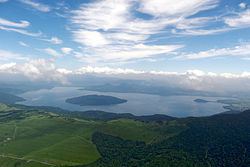Average depth 28.4 m (93 ft) Area 79.3 km² Shore length 57 km Cities Teshikaga | Surface area 79.3 km (30.6 sq mi) Surface elevation 121 m Mean depth 28 m | |
 | ||
Type acidotrophic crater lake Primary inflows Primary outflows Kushiro River (釧路川, Kushiro-gawa) Similar Lake Mashū, Akan National Park, Lake Akan, Mount Iō, Kawayu‑Onsen Station | ||
Lake Kussharo (屈斜路湖, Kussharo-ko) is a caldera lake in Akan National Park, eastern Hokkaidō, Japan. As with many geographic names in Hokkaidō, the name derives from the Ainu language. It is the largest caldera lake in Japan in terms of surface area, and sixth largest lake in Japan. It is also the largest lake in Japan to freeze over completely in winter.
Map of Lake Kussharo, Teshikaga, Kawakami District, Hokkaido Prefecture, Japan
The lake’s central island, Nakajima (not to be confused with another island of the same name in Lake Tōya), is a composite volcano. Volcanic gases render the lake water acidic, and it supports few fish except in areas where inflowing streams dilute the water. Rainbow trout, which are also resistant to fairly acidic water, have been artificially introduced. In 1951, a rare form of cicada (Oncotympana maculaticollis) was discovered, and is now protected by the government. The lake is also on the migratory path of the whooper swan.
Along the lake shore are several outdoor hot springs and a sand beach with naturally heated sand and hot ground water. Wakoto Peninsula extending into the lake has a number of active sulfurous vents.
The lake is also known as Japan’s Loch Ness, after numerous reported sightings on a lake monster dubbed Kusshii by the press from 1973.
